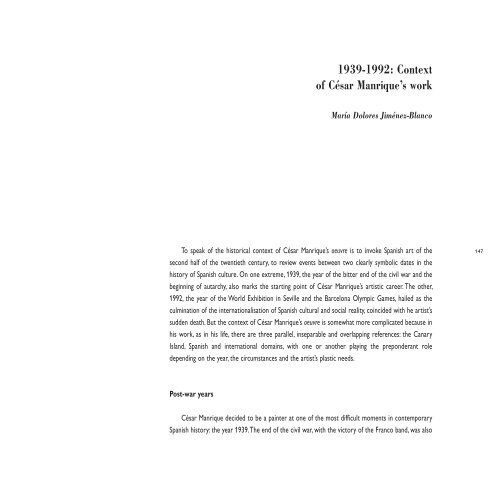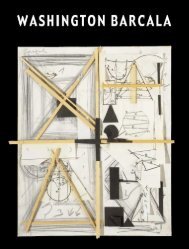VERSIÓN INGLESA ENGLISH VERSION - Fundación César Manrique
VERSIÓN INGLESA ENGLISH VERSION - Fundación César Manrique
VERSIÓN INGLESA ENGLISH VERSION - Fundación César Manrique
Create successful ePaper yourself
Turn your PDF publications into a flip-book with our unique Google optimized e-Paper software.
1939-1992: Context<br />
of <strong>César</strong> <strong>Manrique</strong>’s work<br />
María Dolores Jiménez-Blanco<br />
To speak of the historical context of <strong>César</strong> <strong>Manrique</strong>’s oeuvre is to invoke Spanish art of the<br />
second half of the twentieth century, to review events between two clearly symbolic dates in the<br />
history of Spanish culture. On one extreme, 1939, the year of the bitter end of the civil war and the<br />
beginning of autarchy, also marks the starting point of <strong>César</strong> <strong>Manrique</strong>’s artistic career. The other,<br />
1992, the year of the World Exhibition in Seville and the Barcelona Olympic Games, hailed as the<br />
culmination of the internationalisation of Spanish cultural and social reality, coincided with he artist’s<br />
sudden death. But the context of <strong>César</strong> <strong>Manrique</strong>’s oeuvre is somewhat more complicated because in<br />
his work, as in his life, there are three parallel, inseparable and overlapping references: the Canary<br />
Island, Spanish and international domains, with one or another playing the preponderant role<br />
depending on the year, the circumstances and the artist’s plastic needs.<br />
Post-war years<br />
<strong>César</strong> <strong>Manrique</strong> decided to be a painter at one of the most difficult moments in contemporary<br />
Spanish history: the year 1939. The end of the civil war, with the victory of the Franco band, was also<br />
147
















![Becas y premios de la Fundación César Manrique [1997-2006]](https://img.yumpu.com/20766851/1/184x260/becas-y-premios-de-la-fundacion-cesar-manrique-1997-2006.jpg?quality=85)
